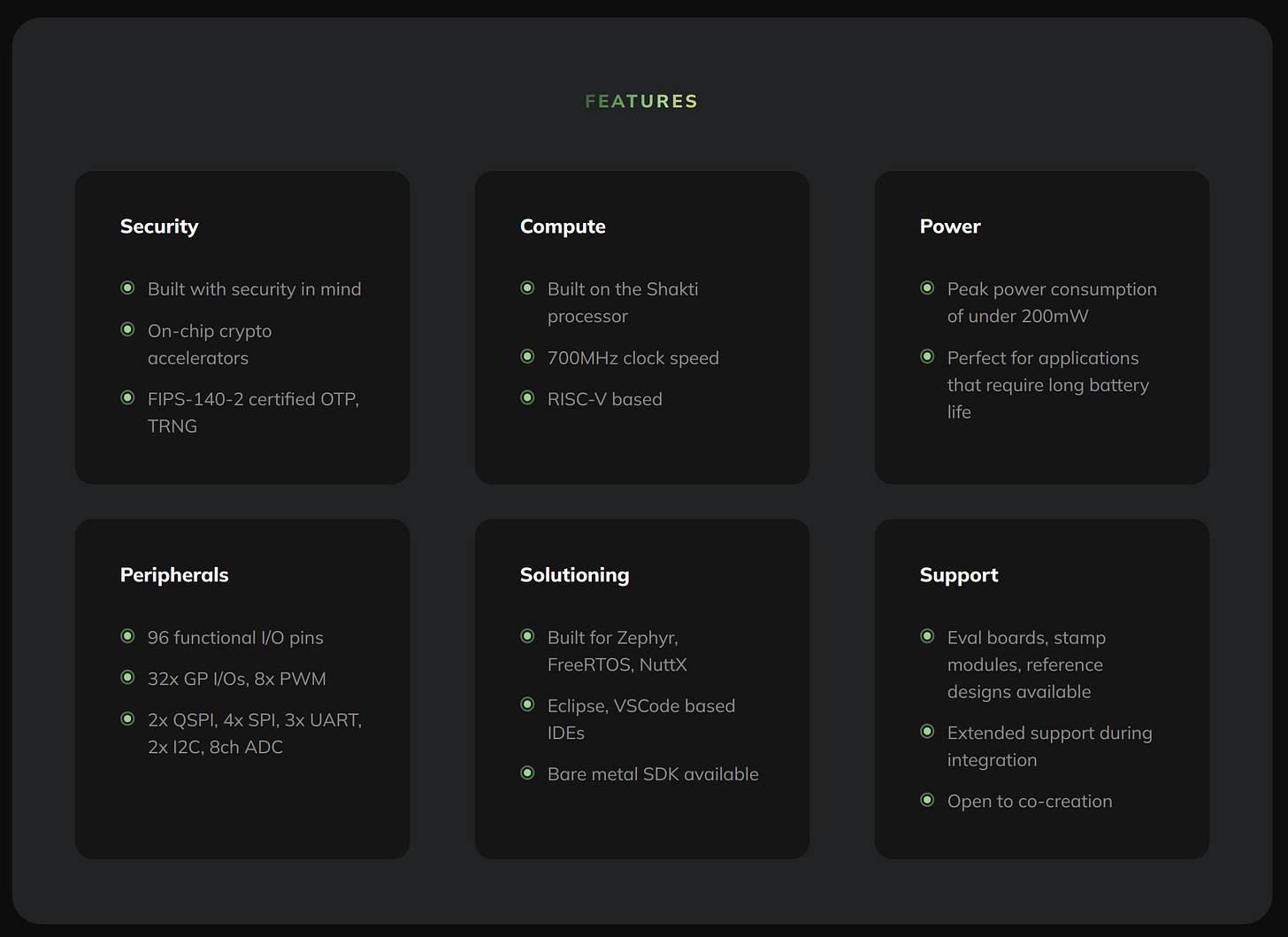A relatively unknown startup, Mindgrove Technologies, has been making news the past few days. They have launched “MG Secure IoT”, a 700 MHz RISC-V microcontroller. Their claim to fame? 30% cheaper than competitor products of a similar class, plus designed in India. As of now, this CNBC TV18 video does a good job of covering the chip, and gives a feel of the company and the stage of development. Media articles don’t dive into the tech; this is an effort cover that gap as best as possible.
The company says it’s going after “high volume” customers first. So good luck getting your hands on a chip and trying it out yourself. This is what the chip looks like:
The datasheet is available only on request to early access (vetted?) customers. This article relies primarily on publicly available material for any guesses.
First - let’s look at the features of the chip. (Note: All screenshots are from Mindgrove’s website)
If you carefully count the pins you’ll find that it’s a 64 pin package - likely a QFN64. This matches their usage of the test socket in the video linked above. 96 functional IO pins is clearly impossible as the chip has only 64 pins - many of which would need to be dedicated to power and ground anyways. Could this be a design customization for volume customers - effectively for creating custom chips? This Times of India article says there is no pin multiplexing (i.e. 96 IO pins), yet shows the 64 pin chip package. That leaves open about what’s shown in the videos… (EDIT: The CEO of Mindgrove has clarified about some of the observations in this post. Do read his comment too to get a complete picture.)
The chip is fabricated using a 28 nm process in Taiwan. 28 nm is pretty good for this application. Peak power consumption of 200 mW is interesting.
There’s nothing “IoT” about the chip itself though, in the sense that it doesn’t support any kind of connectivity to the cloud. That’s not necessarily a bad thing - but usage of “IoT” in the name is certainly misleading. I also hope Mindgrove would get a bit more creative in naming their product. I mean, “MG Secure IoT”… - seriously ? For inspiration they need to look no farther than THEJAS32 from CDAC, and Shakti and Moushik, made by IIT-Madras.
Details of the tech blocks in Secure IOT are below. 700 MHz clock is a good speed, placing it in the “crossover” MCU category. If this is a 64 bit processor, so could be faster for many applications. It is very close to NXP’s iMX-RT 1015, especially if you aren’t looking for USB. Now, why a chip this powerful shouldn’t have a USB interface is something that is beyond me.
XIP Flash over Q-SPI is of course a necessary feature. The other QSPI interface can be used to interface PSRAM. If you want to hookup a graphical display, then you could use a SPI interface, or I2C for something slower. SPI, I2C, UART, GPIOs and PWM features are good enough for most peripheral interfacing needs. 5 MSPS ADC looks good too. Secure IoT also seems to support an RTC, which is A Good Thing! JTAG and Debug and Trace are supported - the tooling support in these areas will be crucial as well.
Overall, the specs seem well rounded, if you don’t need USB support. Omission of I2S could be a problem for some as well. Also, does Secure IoT not have a DMA controller ? Hopefully these only got lost in conversion from the datasheet to the web.
The security features do provide Secure IoT an edge, especially if you are bidding for government contracts and such - where localization requirements can give customers an edge.
Let’s finally look at the 30% lower cost claim1. As a baseline, we’ll consider the iMX RT 1015 as a reference point. While official pricing is approximately $2.17 in 10k quantity in the US, typical prices from online distributors is much higher - between 4.5-5$, albeit in lower volume. Could Mindgrove Technologies supply a chip at a cheaper price ? Perhaps - and maybe by taking a hit at their margins - something they can certainly afford to do for now.
Also, the cost saving - while significant - is a but a part of the cost of the overall device. The additional development switching effort could negate some of those savings, acting as a potential deterrent. How many large customers will jump given the unknowns? We’ll have to wait and see.
In terms of use cases, Mindgrove suggests Smart Locks, Smart Watch, Smart Utility Meters, Thermal Printers, Smart Fans, Biometric Module. A 700 Mhz micrcontroller in a Smart Fan that runs at less than 500 RPM ? Unlikely. Smart watch of the consumer type (but not so much for similar applications such as medical) seems iffy as well. Biometric devices seems a better application match.
Mindgrove defines a few engagement models - Basic, Extended and “Co-develop”, all of which require you to fill the contact form.
If they do support “Basic” then they should consider at-least putting out a datasheet. This can potentially allow more potential customers to actually understand what their offering is - an approach likely to fetch more users. Microcontrollers are a reasonably mainstream product. Also it isn’t the case thatSecure IoT is getting some new tech to the market that isn’t available anywhere. To extend their global reach, they should consider making more collateral available online. Ideally it shouldn’t require getting on a call or filling a form to understand the tech capabilities. Also, it isn’t clear if Mindgrove has eval boards, stamp modules already, or if they are in development. If yes, then I’d say they are better served by at-least putting pictures on the website.
All said, there is at-least a few places where the positioning of the company and the product feels a bit off. For instance, sample their “Utilise our Range”. This is exactly the sort of thing you’d expect from a services company… For a company coming out with their first product, this can be avoided.
All in all, it’s very good to see another microcontroller from India on the way of reaching the market. These are exciting times. I wish Mindgrove Technologies the very best in their endeavours. Looking forward to test the chip sometime soon!
I call this a claim as the cost and competition compared against are not specified by Mindgrove Technologies









Hi, CEO of Mindgrove here.
Thank you for the article - I'm quite happy that you went into so much detail about our chip. But no guesswork necessary; the datasheet is being finalized and will be out very soon. Personally, I hate it when companies don't put out datasheets, so I will not do that to anyone else. Most of your points will find answers there.
But a couple of important ones to address:
1. The chip you see in the photo and in all our press material is indeed a QFN64, which is a prototype only. The intended package for the chip is a 144BGA, and that is the first one that will hit the market. We are also trying to work out variant packages, partly for different price points.
2. Like the datasheet, reference designs, application notes, downloadable software and SDK, devtools and other goodies being worked on and will be made available in the coming weeks.
PS: I'm cross-posting this on your LinkedIn, so that anyone who finds it there will also read this context.
PPS: Yes, I'm horrible at naming things. 🙂
Shaswath, nice of you to respond to Shree's post. Wishing Mindgrove all success. On naming, Indian languages and Indian history offer so many options. Garuda, Pushpak, Vajra, Konark, Lumbini, Kanchi etc are a few names that come to mind. Happy to help with naming.